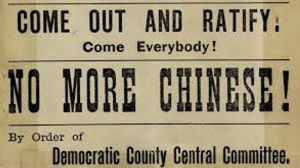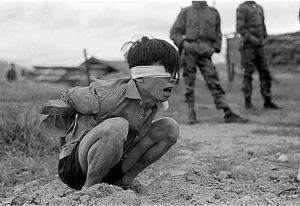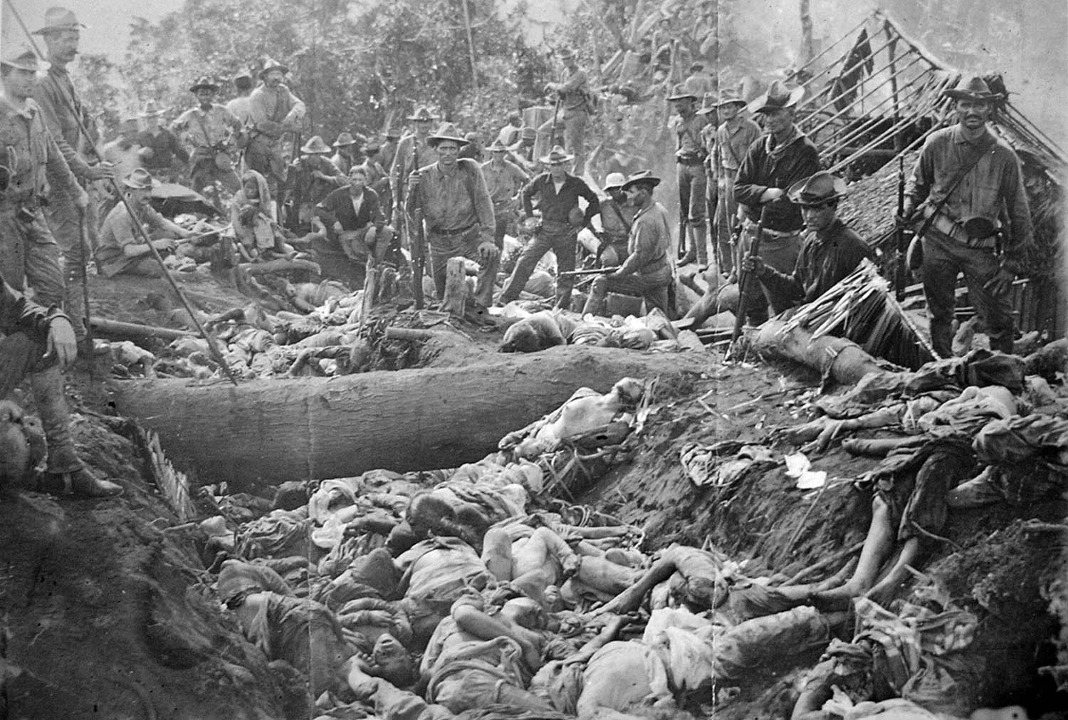More Confusion – No Wonder!
By Mike Morgan
If there was a board game in which the winner would reveal the official historic and current U.S. position towards most of the Far East peoples and their various nation states, what would it be called: Duplicity; Carrots and Sticks; Topsy Turvy; or Leapfrog? Perhaps War or Battleships are the easiest titles to settle on.
Now with the focus front and center on random violence against Asian Americans, it might make sense to cut to the quick. Since the beginning of the last century, the U.S. has poured millions of soldiers, sailors and flyers with all of their hardware into the “Pacific Theater.” Enemies in one decade became allies in the next one, and then swapped back again. Think about this. Americans at home and in uniform abroad had been told to hate the Filipinos, then to like the Chinese, then to hate the Chinese, then to hate the Japanese, then to like the Filipinos, then to really like the Japanese, then to hate the Koreans, then to like some Koreans, then to really hate the Chinese again, then to hate the Vietnamese, the Laotians, the Cambodians, the Indonesians and then feel sorry for some of them and to sort of like them. In this thumbnail sketch, ”hate” means kill, “like” means co-opt.
Most of these U.S. military people fought in the various Far East campaigns. The ones who killed Filipinos saw their offspring kill Japanese. The WWII ones saw their younger brothers and sisters kill Chinese and Koreans. The Korean War veterans saw their children lay waste to Vietnamese. These wars were no cakewalk for the U.S., they took it on the chin too. They lost the one in Vietnam. The unwillingness of some of their own troops to pursue the killing there was one of the reasons for this.
The sheer scale and scope of human misery caused by these wars is difficult to get one’s head around, it was so pervasive. East Asia fast became a laboratory for experimenting on more efficient ways to contain and to kill people. New weaponry was tested out on the battlefields, everything from small arms, to the release of deadly chemical defoliants, to the big daddy of them all, the atomic bomb. And then there was always napalm. Scorched earth policies were enacted. Prison compounds and concentration camps were erected. Sometimes they were called strategic hamlets or protected villages to camouflage their true intent. Barbed wire was back in style. Neighboring countries had their infrastructures blown to smithereens. Millions died and many were non-combatants. It’s all there, verifiable in black and white.
When the U.S. wasn’t firebombing Japanese cities, they were using them later on as rest and relaxation centers for the G.I.s who were killing other Asians somewhere else on the continent or the islands. At one point, there were more American soldiers on leave in Okinawa than Japanese. Clark Air Force Base and Subic Bay Naval Station in their heyday were mini-American metropolises, slap bang in the middle of the Philippines. Thailand was a frontline center for regional American intelligence operations. CIA agents were recognized because most of them drove brazenly around the streets of Bangkok in Ford Pintos (the company car).
Almost a century of protracted warfare both of the conventional and dirty kind created massive upheaval, with relocation and refugees. People were forced to flee. Many came to these shores, some by choice through class allegiances and loyalty to the American mission, others by false promises made by those who oversaw the destruction of their homelands, and many by whatever way they could, even by island hopping in small boats.
Of course, these wars were not the only reason for Far Eastern migration to the U.S., but they played a major role. It bears mentioning that the original influx of Chinese workers into mainly the western part of the U.S. to build the railroads resulted in the passing of the Chinese Exclusion Act of 1882, before all of these foreign military ventures. Much like the descendants of African slaves, the Irish and Italian workers of yesteryear, and the Mexican and Central American ones who are now under the lash, the original Chinese settlers were blamed for a whole lot of things that just weren’t their fault.

The Americans who fought in these Pacific wars and survived also came home. They brought with them all that they had learned or mislearned from their overseas experiences, which was a hodgepodge of stuff, a bunch of it messy. In a society that generally identified all Far Easterners as people with a particular look and who were mostly not to be trusted because they were either the enemy or fair weather friends, and given that last year’s foes were now this year’s buddies, this did not bode well for understanding foreign cultures and cordial relations between the rank and file. It’s now another American made tinderbox, ready to blow maybe. COVID saber rattling is the latest ingredient added to the mix. One cannot rule out the American zombie factor either. It didn’t matter which country these Asian folks hailed from, how obedient and non-threatening to the system and status quo they might have been, to many they were “the other.” Years of occupation had not taught the occupiers much.
It is said that if we don’t try to understand history, we will eventually wind up being wrong and doing wrong things. You can take that to the bank. When I watch the newscasters, the panels of diversity experts, and the elected officials wring their hands and talk in somber tones on television about the increase in anti-Asian violence here, I feel like I am being confronted by people who do not understand what happened before and will never fess up to it even if they do realize it. They decry the violence in Atlanta and in the various Chinatowns across America yet immediately speak in hallowed terms of the brave men and women in uniform. The more self-righteous and deluded ones claim that such brutality is anti-American! Either they are ignorant, or they hide from the past, or they seek to create a historical narrative that is make-believe. This is no trivial pursuit. Do not pass go.
 Vietnam
Vietnam
It’s up to us not to heed the call-up!
By John Garvey
In 1980, the great English band, The Clash, recorded a powerful anti-war song titled The Call-up. While the call-up initially refers to the drafting of soldiers into the armed forces, over the course of the song, it becomes a metaphor for all the efforts of the powerful to maintain support for their more or less endless wars. Here are the lyrics:
It’s up to you not to heed the call-up
‘N’ you must not act the way you were brought up
Who knows the reasons why you have grown up?
Who knows the plans or why they were drawn up?
It’s up to you not to heed the call-up
I don’t want to die!
It’s up to you not to hear the call-up
I don’t want to kill!
For he who will die
Is he who will kill
Maybe I want to see the wheat fields
Over Kiev and down to the sea
All the young people down the ages
They gladly marched off to die
Proud city fathers used to watch them
Tears in their eyes
There is a rose that I want to live for
Although, God knows, I may not have met her
There is a dance an’ I should be with her
There is a town – unlike any other
It’s up to you not to hear the call-up
‘N’ you must not act the way you were brought up
Who give you work an’ why should you do it?
At fifty-five minutes past eleven
There is a rose…
Yeah!
It’s even more powerful when you watch the video
The charge “not to heed the call-up” at first is an expression of the need to resist the draft but it develops into an expression of the need to resist all the dehumanizing aspects of modern life.
I was reminded of the song as I watched some of our “liberal” leaders express their support for a ban on assault weapons, specifically “AR 15 style rifles, in the days after the killing of ten people in a Boulder, Colorado supermarket. What was striking about their arguments was the way in which they took an endorsement of the need to kill as many enemies as quickly as possible, in contrast to doing the same thing in a market, as completely commonsensical and unobjectionable.
First up is Vice President Kamala Harris. In an interview with CBS’s Gayle King, she called on Congress to ban assault rifles: “It is time for Congress to act, and stop with the false choices. This is not about getting rid of the Second Amendment. It’s simply about saying we need reasonable gun safety laws. There is no reason why we have assault weapons on the streets of a civil society. They are weapons of war. They are designed to kill a lot of people quickly.” A civil society?
And then we have Ari Melber, of MSNBC, doing one of his all too familiar special reports—this one on why assault weapons should be restricted to members of the armed forces. During the report, he replayed a 2019 interview with Anthony Brown, a congressman from Maryland and a thirty-year military vet, after two mass shootings with assault rifles. Brown said: “These are the very types of weapons that were issued to me when I went to Iraq, when my colleagues went to Afghanistan. They were issued to us so that we could do a very important mission, if called to do, and that’s kill people. They are designed to inflict as much harm and casualty and death as is humanly possible.” Humanly possible?
The most common military version of the AR15 is the M16 and the numerous varieties of AR15s now available for purchase are knock-offs of the M16. Both are lethal; the only significant difference is that the ones for sale on the consumer market are not fully automatic. The M16 was developed by a number of competing firearms manufacturers in response to requests from different branches of the armed forces. As was true for a lot of dreadful weapons, the prototypes were first tested in Vietnam. The development of the weapons, including the specifications for its function and effectiveness was under the supervision of DARPA (the Defense Advanced Research Projects Agency), a Pentagon outfit that explores new technologies for war and other government priorities.
The early versions of the weapon proved to terrifyingly effective at inflicting death on the forces of the National Liberation Front, the North Vietnamese Army, as well as presumably any other individuals who happened to be in the line of fire. But there were many problems with it. For example, it needed frequent cleaning but soldiers were neither trained in the proper procedures nor provided the necessary gear. Infantry troops spent so much time cleaning the rifles that it was often reported that the most common moment when a soldier was killed occurred while he was cleaning his rifle.
Over the years, numerous modifications were made to the design of the rifles and to the materials used in its manufacture to improve their reliability and endurance. It was a classic instance of the incorporation of the most advanced scientific and technical knowledge for improved capitalist production. And it worked—the M16 remains the go to weapon for the armed forces decades after it was introduced.
The sheer blindness of liberals like Harris and Melber is manifested in their pronouncements. Enemies who get killed “quickly” and “horribly” in war are not seen as real people. Those who died in Boulder matter but dead Iraqis and Afghanis don’t. I’m not trying to argue that there is never a reason for war. I actually think that the somewhat traditional Christian “just war” theory has a lot to recommend it. According to that theory, war is justified if it meets six conditions—having a just cause, being a last resort, being declared by a proper authority, possessing right intention, having a reasonable chance of success, and the end being proportional to the means. If that’s a sound theory, it’s likely that no war that the US has waged in the last 75 years (since the end of World War II) was a just war.
During the fight against the war in Vietnam, many people came to see something of the horrors of war and to understand that the opposition to war was an indispensable foundation of the fight for a new society. In 1980, when the Clash recorded The Call-up, those sentiments were still pretty popular. But today’s liberals want us to forget all about that stuff and to take it for granted that the US needs to be able to kill lots of enemies quickly whenever it’s decided to do so. They want to draw an iron curtain of sorts between what’s OK in war and what’s OK in a supermarket in Colorado.
But the curtain isn’t made of iron. In 2019, Colt Firearms discontinued production of its AR-15 for consumers because the automatic rifle market had “excess manufacturing capacity” (meaning there were too many companies making the damn things) and it needed to devote its own capacity to meeting its obligations to the military and police departments. Remember that these weapons are designed to go on offense and not for self-defense. When members of police forces and other law enforcement agencies are armed with semi-automatics, as they were during many of the anti-police protests of last summer, they’re on offense. They don’t actually have to pull the trigger. Even the un-fired weapon sends a message. It’s often been said that the police act like an occupying army in many black neighborhoods. It may be that it’s not as much of an exaggeration as some might have thought.
At times, the efforts of politicians to drum up support for war are shrill and obvious. At other times, they are understated and not so blatant. Either way, they’re trying to get away with murder. Right now, they’re able to get away with it because there is little of an effective anti-war movement. It’s up to us to change that.
*The featured image is of the U.S. campaign against the Moro people, Philippines, 1906.
***

